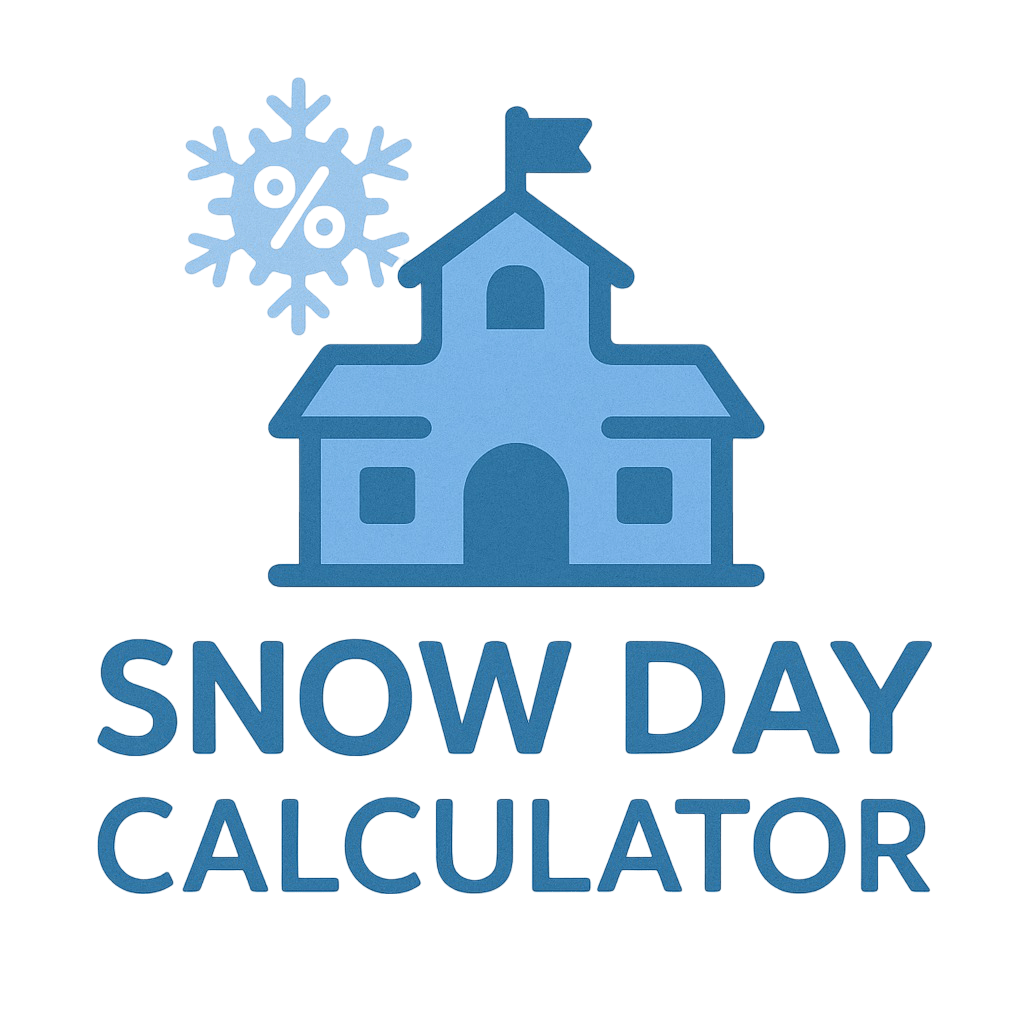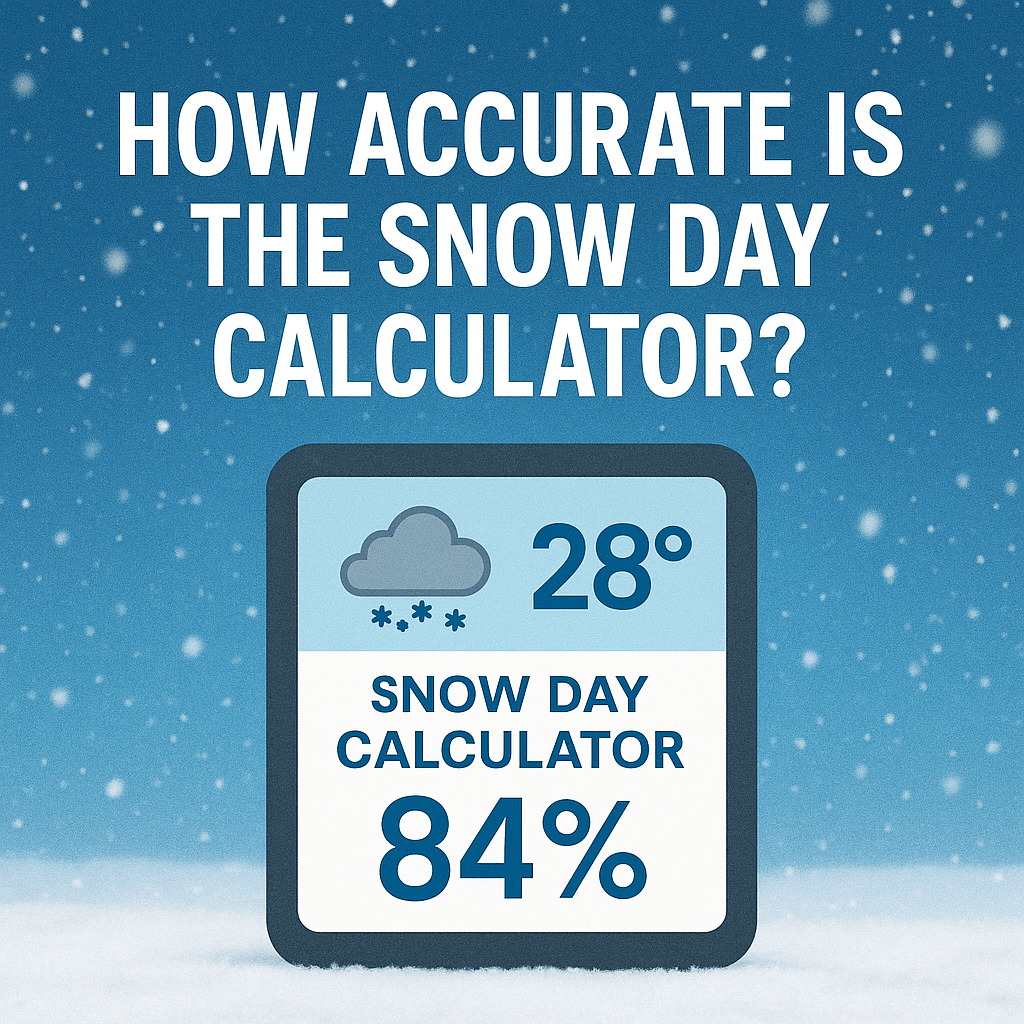1. Introduction
Snow day calculator accuracy is important for anyone relying on predictions about school closures. By understanding how it works and what factors it uses, you can better judge how reliable its forecasts are.
Brief Overview of Snow Day Calculator
Snow day calculator forecast the likelihood of school closures by analyzing weather forecasts, location-specific data, and historical trends. Users input a zip code or city to receive a percentage chance of a snow day, derived from weather services like the National Weather Service and local school policies. While not official, these tools offer a convenient way to anticipate weather-related disruptions.
Why They’re Used
Students use snow day calculator to anticipate a break from classes, while parents rely on them to plan childcare or work adjustments. Schools may informally use them to prepare for transportation or safety challenges, though final closure decisions lie with district officials. Their accessibility makes them valuable for those impacted by winter weather.
This article examines how is the snow day calculator accuracy, data sources, and limitations. It also highlights their benefits for planning during winter weather, helping you understand their reliability and effective use.
2. What Is a Snow Day Calculator?
A snow day calculator is an online tool or app that predicts if schools might close due to winter weather conditions, such as heavy snowfall, ice, or freezing. By analyzing meteorological data, historical closure patterns, and sometimes school district policies, these calculator provide a percentage probability or qualitative estimate (e.g., “very likely” or “unlikely”) of a snow day occurring.
The primary purpose is to help students, parents, teachers, and school administrators anticipate potential cancellations or delays, enabling better planning for childcare, work schedules, or academic adjustments. Beyond practical use, snow day calculator add an element of excitement and anticipation, particularly for students hoping for a day off.
How It Works
Snow day calculator accuracy rely on a combination of data inputs and algorithms to generate predictions:
- Weather Data: They pull real-time and forecasted weather information from trusted sources like the National Weather Service, NOAA, AccuWeather, or local weather stations. Key factors include snowfall accumulation (e.g., inches per hour), temperature (especially below 20°F), wind chill, ice forecasts, and storm timing (e.g., overnight snow affecting morning commutes). For instance, 5–6 inches of snow or icy road conditions often increase closure likelihood.
- School Policies: Some advanced calculators incorporate local school district policies, such as snow accumulation thresholds (e.g., 2–3 inches in southern regions vs. 6+ inches in northern ones) or sensitivity to road conditions. Rural districts may close sooner than urban ones with better snow infrastructure. However, not all tools directly account for policies, relying instead on user inputs or historical trends.
- Historical Trends: By analyzing past closure patterns for specific schools or regions, calculator refine predictions. For example, districts that closed for 4 inches of snow in the past are more likely to do so again under similar conditions. Machine learning and user feedback further enhance snow day calculator accuracy over time as the system learns regional norms.
- User Inputs: Users typically enter a ZIP code, city name, or school type (public, private, or college) to localize predictions. Some platforms allow manual input of weather data or recent closure information to improve precision.

3. Snow Day Calculator Accuracy
The Snow Day Calculator is a popular tool designed to predict the likelihood of school closures due to winter weather, offering students, parents, and educators a data-driven way to anticipate snow days. But how accurate and reliable is it? This article explores the Snow Day Calculator Accuracy, the factors influencing its predictions, and real-life usage insights, including anecdotal evidence of its performance.
General Accuracy and Reliability of the Snow Day Calculator
The Snow Day Calculator accuracy gives a percentage estimate of how likely schools are to close due to winter weather (for example, a 70% chance of a snow day). Its accuracy generally ranges from 65-90% in regions with consistent winter weather patterns, such as the northeastern U.S. or Canada, but reliability can vary depending on location and weather unpredictability.
The tool leverages advanced algorithms that analyze real-time weather data from trusted sources like the National Weather Service (NWS), AccuWeather, or NOAA, combined with historical closure patterns and school district policies. Some platforms, like snowdaycalculator.com, claim up to 95% accuracy by integrating live weather updates, district-specific thresholds, and historical data. However, no calculator is infallible due to the inherent unpredictability of weather and human decision-making by school administrators.
Key Points on Reliability:
- Short-term forecasts (1-2 days): Snow Day Calculator Accuracy is highest, often 80-90%, as weather data is more precise closer to the event.
- Longer-term forecasts (3-10 days): Accuracy drops significantly, sometimes below 65%, due to weather variability.
- Regional performance: More reliable in snow-prone areas (e.g., Michigan, Ontario) than in regions with rare snow (e.g., southern U.S.).
- Not a replacement for official notices: Calculators are guidelines, not definitive predictors, as school closure decisions involve factors beyond weather.
Factors That Affect Snow Day Calculator Predictions
Several variables influence the Snow Day Calculator accuracy, including location, weather forecast reliability, and school district decision-making processes.

- Location and Local Conditions:
- Geographic variations: Snow day thresholds vary by region. For example, 2-3 inches of snow may close schools in southern states, while northern states like Minnesota may require 6+ inches.
- Microclimates and elevation: Areas near lakes, mountains, or at higher elevations experience unique weather patterns, which can complicate predictions.
- Infrastructure: Regions with limited snow removal resources (e.g., rural areas) are more likely to close schools, impacting prediction models.
- Weather Forecast Accuracy:
- Data quality: Snow Day Calculator Accuracy rely on meteorological data from sources like NOAA or AccuWeather. Inaccurate or outdated data reduces prediction precision.
- Weather unpredictability: Slight changes in temperature, humidity, or wind can turn snow into rain or sleet, affecting outcomes.
- Timing of storms: Snow during early morning commute hours (5-8 AM) increases closure likelihood, which calculator factor in.
- School District Decisions:
- Historical patterns: Calculator use past closure data to predict future decisions, but inconsistent district policies can skew results.
- Administrative leniency: Some districts close schools proactively, while others prioritize staying open, affecting prediction reliability.
- Non-weather factors: Road conditions, bus route safety, and emergency management decisions often outweigh raw weather data.
Real-Life Usage and Anecdotal Accuracy
The Snow Day Calculator is widely used by students, parents, and educators for planning purposes, with millions accessing it during winter weather events, especially during major storms like the 2019 polar vortex. Its real-life utility lies in reducing uncertainty and aiding preparation, such as arranging childcare or adjusting lesson plans. Let’s explore snow day calculator accuracy and how it performs in real-world conditions.
- User Experiences:
- Students and parents: Many report the calculator as a “lifesaver” for planning work and family schedules, with predictions often aligning with actual closures in snow-heavy regions. For instance, users on platforms like Reddit praise the snow day calculator accuracy for short-term forecasts.
- Educators and administrators: Schools use it to anticipate closures and communicate with stakeholders, though they rely on official weather alerts for final decisions.
- Anecdotal accuracy: Users frequently cite 70-90% accuracy in regions like the U.S. Northeast or Canada, with tools like Snowdaycalc.net being “right more often than wrong.” However, some report disappointments when calculator overestimate closure chances due to unexpected weather shifts or conservative school policies.
4. Pros of Using a Snow Day Calculator
Quick Predictions: A Snow Day Calculator provides rapid forecasts about the likelihood of school closures due to snow or severe weather. By inputting data like location, weather conditions, or historical trends, it generates an instant estimate, saving time compared to manually checking weather reports or waiting for official announcements.
Fun and Engaging for Students: These calculator are often designed with a playful, user-friendly interface that appeals to students. The excitement of predicting a potential day off from school makes the tool entertaining, turning weather forecasting into an interactive game that keeps students engaged.
Helps in Planning Ahead: By estimating the chance of a snow day, the calculator allows students, parents, and even teachers to prepare in advance. Families can adjust schedules, arrange childcare, or plan indoor activities, while students can prioritize homework or enjoy the anticipation of a possible day off with better clarity.
5. Expert Opinion and Data Review for Snow Day Calculator
Meteorologist Insights: Experts like NOAA’s James Hoke emphasize snow forecasting’s complexity due to variables like temperature and storm tracks. Short-term predictions are reliable, supporting snow day calculator for quick forecasts.
Snow Prediction Studies: Research, like a 2023 study on mountain snowfall, shows machine learning models achieve up to 82% accuracy by analyzing elevation and weather data. NOAA and Environment Canada data enhance calculator reliability.
AI and Machine Learning: Snow day calculator use AI to process real-time weather, historical closures, and local factors. Tools like Snow Day Predictor leverage algorithms for fast, accurate probability scores, improving user planning.
Why It Matters: These insights ensure quick, engaging predictions, helping families plan ahead with reliable, data-driven snow day forecasts.
6. How to Choose the Best Snow Day Prediction Tool
Match Tool with Your Location: Ensure the tool covers your specific area, as weather patterns vary by region. Check if it uses local weather data or supports your zip code.

Check Update Frequency: Look for tools that update frequently (e.g., hourly or daily) to reflect the latest weather forecasts for accurate predictions.
Prioritize Official School Alerts: Rely on official school or district announcements first, as they confirm closures based on local conditions and policies.
Use Calculator for Fun or Backup: Snow day calculator, like online predictors, are less reliable but can be fun or serve as a secondary check. They often use basic weather data and algorithms but lack official authority.
7. Conclusion
Recap of Calculator’s Strengths and Weaknesses: Snow day calculator is user-friendly, often free, and provide quick predictions using basic weather data like snowfall and temperature. They’re engaging for students and families. However, they lack precision, rely on generalized algorithms, and don’t account for local school policies or real-time updates, making them less reliable than official sources.
Final Verdict on Snow day calculator Accuracy: Snow day calculator is not highly accurate. They offer rough estimates but can’t match the reliability of official school alerts or detailed weather forecasts.
Recommendation: Use snow day calculator as a fun, supplementary tool for entertainment, but don’t rely on them for guaranteed predictions. Always check official school announcements for accurate closure information.
8. Frequently Asked Questions (FAQs)
Q: Is the snow day calculator accurate for rural areas?
A: It can be less accurate due to limited weather data and unpredictable school policies.
Q: Does it predict early dismissals or late starts?
A: Most calculators focus on full-day closures only.
Q: Is the calculator available in Canada and the UK?
A: Yes, some calculator support postal codes outside the U.S., though accuracy varies.


1 thought on “Snow Day Calculator Accuracy: How Reliable Are Predictions?”